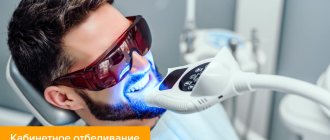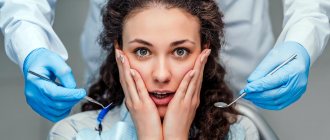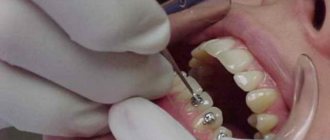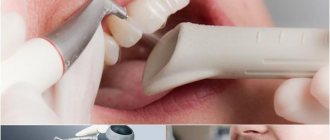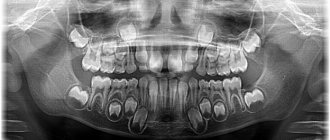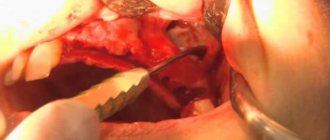Do you want to know in detail what dental caries is, how to treat it and the causes of its occurrence? This dental problem is physiological and aesthetic in nature. Damage and gradual destruction of tooth enamel can cause a person a lot of unpleasant experiences. To prevent the disease from progressing, it is necessary to treat it in a timely manner. Are you interested in the question of when to treat caries? Depending on the stage of the disease and the speed of its progression, you have a varying amount of time at your disposal. At any of its stages, it is best to seek medical help as quickly as possible in order to avoid much more serious consequences for your health.
How does caries develop?
Caries is a pathological process that destroys the hard tissues of the tooth. By its nature, it is sluggish and usually occurs under the influence of negative environmental factors or internal problems of the body. Bacteria in the oral cavity produce organic acid that corrodes the enamel, which leads to the development of pathology. The more bacteria, the more acid and, accordingly, the greater the damage.
In this article
- How does caries develop?
- Is it possible to remove caries at home?
- How to remove caries at home using folk remedies?
- What is effective against caries at home?
- The influence of dietary habits on caries
- Good immunity reduces the risk of developing caries
- How to brush your teeth and how to rinse your mouth to prevent caries
- Don't forget about professional hygiene
- Conclusion
Often the disease begins under the surface of the tooth, so in the absence of pronounced symptoms, it is not always possible to notice it at an early stage without the help of a doctor. Early caries looks like a white dot on the enamel surface. At the same time, most people imagine carise as a huge hole in the tooth. Therefore, often a person with early caries does not suspect that a pathological process has begun in his tooth.
A person can know that there is caries in a tooth when the carious cavity expands to the upper part of the tooth or when acute toothache signals this. The most correct and safe option for any dental problems is to contact a dental clinic as quickly as possible. But if for some reason this is not possible, people are looking for a way to cure tooth decay on their own.
Children and pregnant women: features of their treatment
Methods of dealing with dental problems in a child depend on his age. When looking for an answer to the question of how caries of baby teeth is treated, you need to take into account the degree of neglect of the disease. Delivering a lot of unpleasant experiences to a small patient, it affects the growth and development of permanent (molar) teeth. To prevent them from being damaged during teething, you should not turn a blind eye to the existing carious cavities in your child’s mouth. How to treat bottle caries is decided directly by the dentist himself, in consultation with the baby’s parents.
Many expectant mothers are concerned about the question of whether caries can be treated during pregnancy. The likely consequences and negative effects of painkillers on the developing fetus frighten most pregnant women. Exposure to an even greater risk of developing this disease, young mothers should treat their health with increased attention. Beginning damage to tooth enamel should be stopped immediately to prevent possible complications in the form of pulpitis or the development of a cyst.
Is it possible to remove caries at home?
This question may arise in the following cases:
- a person is afraid of dentists and is willing to risk his dental health rather than go to the doctor;
- there is no opportunity to visit a doctor for objective reasons (for example, on a long trip or when there is no good clinic nearby);
- a small child resists dental treatment in the dentist's office;
- no money for dental treatment.
In most cases, it is impossible to get rid of caries at home.
But there are medicinal methods that help strengthen the enamel and stop the pathological process at an early stage, when caries looks like a white speck on the enamel. To do this, use gels that restore enamel and means for its remineralization.
You can use these anti-caries remedies at home, but a dentist must prescribe them and monitor the process.
How to remove caries at home using folk remedies?
In addition to the medicinal approach, there are a lot of popular recommendations on how to get rid of caries at home. Here are a few recipes that traditional medicine offers:
- Rinse your mouth with sage infusion.
One tablespoon is poured with boiling water, the broth is left for about an hour, and then a cotton swab is moistened in the resulting infusion and applied to the affected tooth. After this, you need to rinse your teeth and mouth with sage. Dentists note that sage is indeed a natural antiseptic and can prevent the growth of bacteria. But this remedy does not help cure dental caries at home; it can only temporarily slow down the process or serve as a preventive measure for caries.
- Apply fir oil to the tooth.
Another popular recommendation is to apply a cotton swab with fir oil to the sore tooth. You will not be able to remove caries with this remedy on your own, but it can temporarily provide a good analgesic effect. You should make an appointment with a doctor as soon as possible, because pain in the teeth may indicate complicated caries or pulpitis.
- Garlic.
There are many folk tips for home treatment of caries using garlic. It is recommended to apply it to the tooth, lean it against the cheek on the side of the diseased tooth, and soak the enamel with juice. And although garlic’s ability to destroy microbes is beyond doubt, it is powerless in the fight against tooth decay. At best, it will partially relieve pain, but it certainly will not help cure deep caries.
- Onion peel.
To treat caries at home, it is suggested to prepare a decoction of onion peels, leave it for several hours and use it as a mouth rinse. The infusion has an antiseptic effect and slightly dulls the pain. There are dozens of other folk recipes that suggest rinsing your mouth, applying something to tooth enamel, or rubbing it into your gums.
- Self-medication is dangerous and unprofitable
It is important to treat any folk remedies critically and remember that their use not only does not guarantee recovery, but can sometimes be dangerous. For example, tinctures for rinsing with alcohol cause damage to the mucous membrane, ulcers and tissue erosion.
You must understand that the development of caries in most cases can be stopped only by removing damaged tooth tissue and filling the cavity. No herbal infusion can cope with this task.
Trying to cure caries at home, a person triggers the pathological process to such an extent that serious complications can arise, and caries spreads to the soft tissues of the tooth. And then, in any case, it will not be possible to avoid visiting the dentist, only the treatment process will be longer, more painful and will require significant financial costs.
Is it easy to detect tooth damage?
When caries first appears, it appears as a white or brown spot. Due to the small size of the defect, the patient will most likely not notice the problem. Only people with increased sensitivity of the enamel may experience pain, which will prompt the idea of contacting a specialist.
As the pathology progresses, the patient will experience the following symptoms:
- pain in response to irritants (sour, sweet, cold, hot foods) or chewing hard foods;
- the appearance of brown or black areas on the tooth;
- coating on the tongue;
- the formation of a cavity that can be palpated with the tongue and can scratch and injure its mucous membrane;
- bad breath that does not disappear after proper cleaning and use of mouthwash.
If these signs of illness appear, you need to visit the dentist in the coming days and undergo the recommended treatment. No folk remedies will help eliminate caries! Even if the tooth begins to hurt less or the pain subsides altogether, a consultation with a dentist is necessary. Otherwise, the development of complications cannot be avoided.
The influence of dietary habits on caries
The destruction of the enamel structure is facilitated by the acid secreted by bacteria. It is formed in large quantities when consuming carbohydrate foods. Therefore, to prevent caries, it is necessary to limit the consumption of sweets and sugar, and after eating sweet foods, be sure to rinse your mouth.
Caries develops faster when the enamel becomes thinner. In order for teeth to be strong and less susceptible to decay, the body must receive sufficient amounts of vitamins and microelements. They can be taken as a multivitamin as prescribed by your doctor, but it is best to take them through food. To do this, the diet must be varied and balanced, it must contain dairy products, fish, cheese, and fresh herbs.
It is useful to eat solid vegetables and fruits (carrots, apples). They mechanically clean the enamel from plaque and stimulate blood flow in the gums. Avoid eating foods and drinks that are too hot or too cold. Due to temperature changes, microscopic cracks form on the enamel, which contributes to the development of caries.
Good immunity reduces the risk of developing caries
The bacteria that cause tooth decay are part of the normal microflora of the oral cavity. But with weakened immunity and other accompanying factors, they can cause caries. At home, everyone can prevent this dental disease by strengthening the immune system. This is facilitated by hardening, reducing stress levels, quality sleep at night, proper nutrition, giving up bad habits, and maintaining a normal weight.
The fewer factors that weaken the immune system, the lower the risk of dental caries.
Main stages of the procedure
If for caries in the stain stage, treatment comes down to brushing the teeth with a special brush, applying a remineralizing composition and taking medications to strengthen the enamel, then in later stages it is necessary to remove the affected tissue and fill the cavity. In this scenario, the principle of caries treatment is as follows:
- anesthesia;
- preparation of a carious cavity;
- removal of infected tissue;
- cavity treatment;
- tooth filling.
Caries treatment and filling are carried out in one appointment. If, during the treatment of caries, damage to the dental pulp is detected, it may require its removal.
How to brush your teeth and how to rinse your mouth to prevent caries
Everyone can take care of their dental and oral health without leaving home. To do this, you must follow the rules of hygiene:
- Brush your teeth twice a day using the correct technique for at least two to three minutes.
- Use fluoride toothpaste (if recommended by your dentist).
- After brushing your teeth, be sure to use dental floss to remove food debris and plaque from the interdental spaces.
- Using an irrigator helps to achieve the maximum degree of cleanliness. This device creates a powerful stream of water that removes dirt from areas of the mouth where a toothbrush cannot reach.
- It is important to brush not only your teeth, but your tongue and the inside of your cheeks. Plaque also accumulates on them and bacteria that cause caries multiply.
- Use special rinses after cleaning. They have an antimicrobial effect, preventing the proliferation of pathogenic microorganisms in the oral cavity.
Fluoritray device
The device is manufactured in Israel by Fluorinex. The kit includes a tray with a sponge, an electrophoresis kit (container and battery), saline solution and fluoride gel.
Before the procedure, a small amount of Vaseline is applied to the gums for protection. A sponge is moistened with copper chloride, the tray is placed in the mouth, and the upper teeth are immersed in the preparatory solution for 1 minute. Do the same with the lower jaw.
The fluoride gel is then poured into a container to which a power supply is attached, after which the tray is placed in the mouth for 4 minutes. First, the medicine acts on the upper jaw, and then on the lower jaw.
Electric waves contribute to the formation of a protective layer on the surface of the teeth, preventing plaque from settling and the proliferation of bacteria. It is recommended to do the procedure once a year.
Don't forget about professional hygiene
No matter how carefully you take care of your oral cavity at home, you need to undergo a professional cleaning procedure at the dentist twice a year. In a clinical setting, you can effectively remove complex dental deposits and restore the normal mineral balance of tooth enamel. If you wear braces, professional cleaning should be done at least three times a year.
Professional oral hygiene and further care at home along with other caries prevention measures will help to reliably protect tooth enamel from destruction.
Fissure sealing is a way to prevent or slow down caries in a child
Caries in a child can be stopped by fissure sealing. Fissures are the natural grooves and grooves on the chewing surface of the teeth. The anatomical features of their structure are such that food debris is easily retained in the fissures, and the process of enamel mineralization is slower than in other areas of the teeth.
To prevent dental caries (most often in children, but the method is also applicable for adults), fissures are sealed. The essence of the method is that natural grooves are covered with special dental sealants containing calcium and fluoride. Sealants seal the tooth, preventing the impact of cariogenic factors on it, and the mineral components included in the composition nourish the dental tissues.
The main indication for sealing is deep fissures that are difficult to clean during daily oral hygiene.
It is optimal for a child to seal the grooves on the teeth six months after teething. At about 6-8 years old, the child’s permanent teeth begin to be sealed - first the first molars, closer to 10 years - the premolars, and by the age of 12-13 - the second molars.
Sealing is not carried out if caries has already formed in the fissures - like a stain or a cavity in the tooth.
The sealing procedure can be invasive or non-invasive; the technology is selected by the doctor individually for each patient. If the fissure is clearly visible, it is sealed using a non-invasive method: the tooth is cleaned of plaque, treated with a special gel that ensures reliable fixation of the filling, sealant is applied and illuminated with a lamp. For narrow and deep fissures, the bottom and walls of which are difficult to see to ensure the absence of caries, the dentist chooses an invasive sealing method.
After cleaning the tooth, the fissures are opened with a drill and their condition is assessed. In the absence of carious lesions, further sealing is carried out similarly to the non-invasive method. Fissure sealing is one of the most effective ways to prevent caries in chewing teeth.

